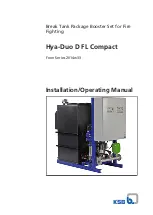
3 Transport/Temporary Storage/Disposal
13 of 48
Hya-Duo D FL Compact
Table 4:
Ambient conditions for storage
Ambient condition
Value
Relative humidity
50 % maximum
Ambient temperature
0 °C to +40 °C
▪
Frost-free
▪
Well-ventilated
3.4 Return to supplier
1. Drain the break tank package booster set for fire fighting as per operating
instructions.
2. Flush and clean the break tank package booster set for fire fighting, particularly
if it has been used for handling noxious, explosive, hot or other hazardous
fluids.
3. If the break tank package booster set for fire fighting has handled fluids whose
residues could lead to corrosion damage in the presence of atmospheric
humidity or could ignite upon contact with oxygen, the break tank package
booster set for fire fighting must also be neutralised, and anhydrous inert gas
must be blown through the break tank package booster set for fire fighting to
ensure drying.
4. Always complete and enclose a certificate of decontamination when returning
the break tank package booster set for fire fighting. (
Always indicate any safety measures and decontamination measures taken.
NOTE
If required, a blank certificate of decontamination can be downloaded from the
following web site:
www.ksb.com/certificate_of_decontamination
3.5 Disposal
WARNING
Fluids handled, consumables and supplies which are hot and/or pose a health
hazard
Hazard to persons and the environment!
▷
Collect and properly dispose of flushing fluid and any fluid residues.
▷
Wear safety clothing and a protective mask if required.
▷
Observe all legal regulations on the disposal of fluids posing a health hazard.
1. Dismantle the break tank package booster set for fire fighting.
Collect greases and other lubricants during dismantling.
2. Separate and sort the pump materials, e.g. by:
- Metals
- Plastics
- Electronic waste
- Greases and other lubricants
3. Dispose of materials in accordance with local regulations or in another
controlled manner.




























